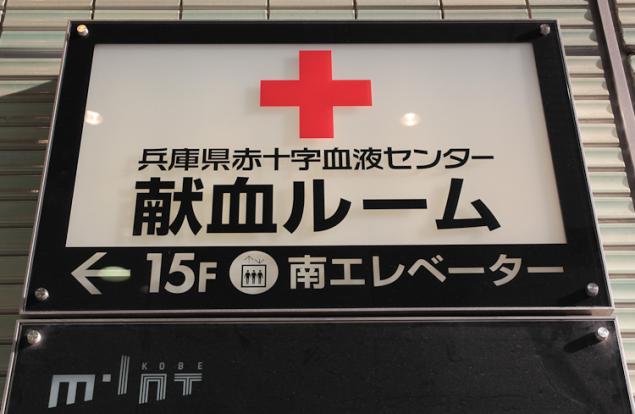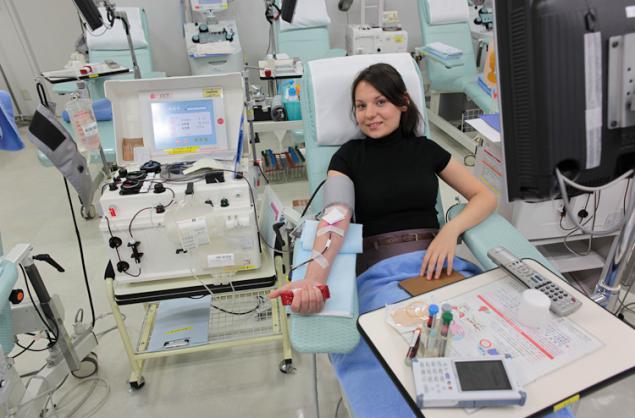1219
Donation to Japan
Man, though a little indifferent to the problems of blood donation, it is very difficult not to donate blood in Japan at least once, as there are constantly campaigning on the streets, and advertising companies are involving celebrities.
I have a third group of blood, and in Russia on transfusion stations I have always been happy as among Europeans is not the most common blood group: in Russia can talk about 10% of the population, and some countries even less fortunate. 3 blood group is considered to be Asian. At the time, I found the numbers of distribution of blood groups in the countries, and I remember my surprise when I learned that in Japan a little less than 30% of the population have a third group of blood.
Japan is engaged in the collection of blood to the Japanese Red Cross. You can donate blood in blood centers, small offices, as well as in mobile buses, which can often be found at train stations and in crowded areas. I was always comfortable to donate blood transfusion center, so today my report will be about one of these stations.
via nobody-s-fool

2. Next to the blood donation centers are generally set stands on which mapped the situation at the moment, is always at least one blood group, which is required urgently. I think these pictures have some motivating effect.

3. What surprises me every time I come to the station transfusion, so is the number of Japanese who constantly give blood. In Russia, I have never seen such a rush, even despite the fact that we honor donors receive benefits and compensation. Popular for a special donation in Russia uses only among students. In my student days for blood donation paid 150 rubles and gave a certificate of exemption from school for 2 days. Nothing like that in Japan there is.
If you came to donate blood for the first time, you must first fill out a number of documents. At this stage you can specify that you would like to obtain a complete blood count, if you're interested. Results are usually sent to the home address in 2-3 weeks after delivery.
After filling out the documents you will be given a personal card of the donor, on the reverse side of which will be given your personal number in the database, the name, the number of blood donations with a detailed history and the earliest possible date to resit. 4. In Russia, I did not have any such card. Doctors themselves are my data in its computer database upon presentation of a passport.
List of requirements for donors in Japan is fairly standard, except that the blood can not pass the person in whom the period of stay in Europe was more than 1 month in the period from 1980 to 1996. This is associated with cases of a new type of infection Creutzfeldt - Jakob disease. Actually, it automatically reduces the ability of foreigners who came from Europe to make its own contribution to the system of donation. Russia is not included in any list with restrictions on blood donation.
Once all of the forms are filled, further procedures can wait in the hall with the established TV, laptop with Internet access, and machine guns with free drinks. Also there is a fridge with ice cream, on which hangs an ad asking to take only one. Although the idea of ice cream in any case I do not understand, because recommended to drink plenty of hot drinks is to expand the vessels before delivery. But immediately after giving blood gets cold, so I want to eat ice cream even less. But some Japanese eat.

5.

6.

7.

8. Next, the donor is invited to inspect where the pressure is measured, and a small amount of blood is taken to determine the level of hemoglobin. Here you can find out your blood type, if you have never had the opportunity somewhere to get this information

9. If all indicators are normal, then you can proceed to the immediate delivery of blood.
In Japan, you can deliver whole blood in a volume of 200 or 400 ml, and plasma or platelets.
By the way, here found differences between Russia and Japan. In Russia, allowed to take the whole blood every 2 months, but not more than 4 times a year for women and 5 times for men. Imagine my surprise when I was told in Japan that I can re-donate blood only after 4 months. In men, the interval is shorter - 12 weeks. The total volume of whole blood donated per year, must not exceed 1200 ml for males and 800 ml for females.
This time I decided to try to pass the plasma, as did not do it never in all my 8 years of donor practices.
It is believed that the plasma is easier to take: the body recovers in 2-3 days. Upon delivery of whole blood for the restoration may require 2-3 weeks.
While I was connected to the machine, I had the opportunity to talk with a nurse. She wondered how the blood donation in Russia. In turn, she told me what a plazmafareza procedure, which is used specifically plasma and that all collected that day will go to the production of plasma medicine.

10. After all the procedures returned me my donor card with updated data and point card, which introduced since 2008. With the accumulation of the required number of Points donor receives a commemorative gift. Although I'm not sure that someone is willing to hand over 1, 2 liters of blood just to get a gift.
In these centers, and other promotions to attract donors, and also trying to motivate people to donate blood during working days to distribute the load. If last visit I saw the ad, which states that every Thursday to 30 people who give blood from 10 to 13 hours will receive a green tea and sweets for free, but now you can see the ads that you are also in the other weekdays are ready to treat dessert to do a hand massage and even tell fortunes by the Tarot.
To the left hangs a poster from which I learned that you can also participate in a haiku contest on the theme of life and donation. I do not remember anything like this in Russia.

Source: http: //
I have a third group of blood, and in Russia on transfusion stations I have always been happy as among Europeans is not the most common blood group: in Russia can talk about 10% of the population, and some countries even less fortunate. 3 blood group is considered to be Asian. At the time, I found the numbers of distribution of blood groups in the countries, and I remember my surprise when I learned that in Japan a little less than 30% of the population have a third group of blood.
Japan is engaged in the collection of blood to the Japanese Red Cross. You can donate blood in blood centers, small offices, as well as in mobile buses, which can often be found at train stations and in crowded areas. I was always comfortable to donate blood transfusion center, so today my report will be about one of these stations.
via nobody-s-fool

2. Next to the blood donation centers are generally set stands on which mapped the situation at the moment, is always at least one blood group, which is required urgently. I think these pictures have some motivating effect.

3. What surprises me every time I come to the station transfusion, so is the number of Japanese who constantly give blood. In Russia, I have never seen such a rush, even despite the fact that we honor donors receive benefits and compensation. Popular for a special donation in Russia uses only among students. In my student days for blood donation paid 150 rubles and gave a certificate of exemption from school for 2 days. Nothing like that in Japan there is.
If you came to donate blood for the first time, you must first fill out a number of documents. At this stage you can specify that you would like to obtain a complete blood count, if you're interested. Results are usually sent to the home address in 2-3 weeks after delivery.
After filling out the documents you will be given a personal card of the donor, on the reverse side of which will be given your personal number in the database, the name, the number of blood donations with a detailed history and the earliest possible date to resit. 4. In Russia, I did not have any such card. Doctors themselves are my data in its computer database upon presentation of a passport.
List of requirements for donors in Japan is fairly standard, except that the blood can not pass the person in whom the period of stay in Europe was more than 1 month in the period from 1980 to 1996. This is associated with cases of a new type of infection Creutzfeldt - Jakob disease. Actually, it automatically reduces the ability of foreigners who came from Europe to make its own contribution to the system of donation. Russia is not included in any list with restrictions on blood donation.
Once all of the forms are filled, further procedures can wait in the hall with the established TV, laptop with Internet access, and machine guns with free drinks. Also there is a fridge with ice cream, on which hangs an ad asking to take only one. Although the idea of ice cream in any case I do not understand, because recommended to drink plenty of hot drinks is to expand the vessels before delivery. But immediately after giving blood gets cold, so I want to eat ice cream even less. But some Japanese eat.

5.

6.

7.

8. Next, the donor is invited to inspect where the pressure is measured, and a small amount of blood is taken to determine the level of hemoglobin. Here you can find out your blood type, if you have never had the opportunity somewhere to get this information

9. If all indicators are normal, then you can proceed to the immediate delivery of blood.
In Japan, you can deliver whole blood in a volume of 200 or 400 ml, and plasma or platelets.
By the way, here found differences between Russia and Japan. In Russia, allowed to take the whole blood every 2 months, but not more than 4 times a year for women and 5 times for men. Imagine my surprise when I was told in Japan that I can re-donate blood only after 4 months. In men, the interval is shorter - 12 weeks. The total volume of whole blood donated per year, must not exceed 1200 ml for males and 800 ml for females.
This time I decided to try to pass the plasma, as did not do it never in all my 8 years of donor practices.
It is believed that the plasma is easier to take: the body recovers in 2-3 days. Upon delivery of whole blood for the restoration may require 2-3 weeks.
While I was connected to the machine, I had the opportunity to talk with a nurse. She wondered how the blood donation in Russia. In turn, she told me what a plazmafareza procedure, which is used specifically plasma and that all collected that day will go to the production of plasma medicine.

10. After all the procedures returned me my donor card with updated data and point card, which introduced since 2008. With the accumulation of the required number of Points donor receives a commemorative gift. Although I'm not sure that someone is willing to hand over 1, 2 liters of blood just to get a gift.
In these centers, and other promotions to attract donors, and also trying to motivate people to donate blood during working days to distribute the load. If last visit I saw the ad, which states that every Thursday to 30 people who give blood from 10 to 13 hours will receive a green tea and sweets for free, but now you can see the ads that you are also in the other weekdays are ready to treat dessert to do a hand massage and even tell fortunes by the Tarot.
To the left hangs a poster from which I learned that you can also participate in a haiku contest on the theme of life and donation. I do not remember anything like this in Russia.

Source: http: //























